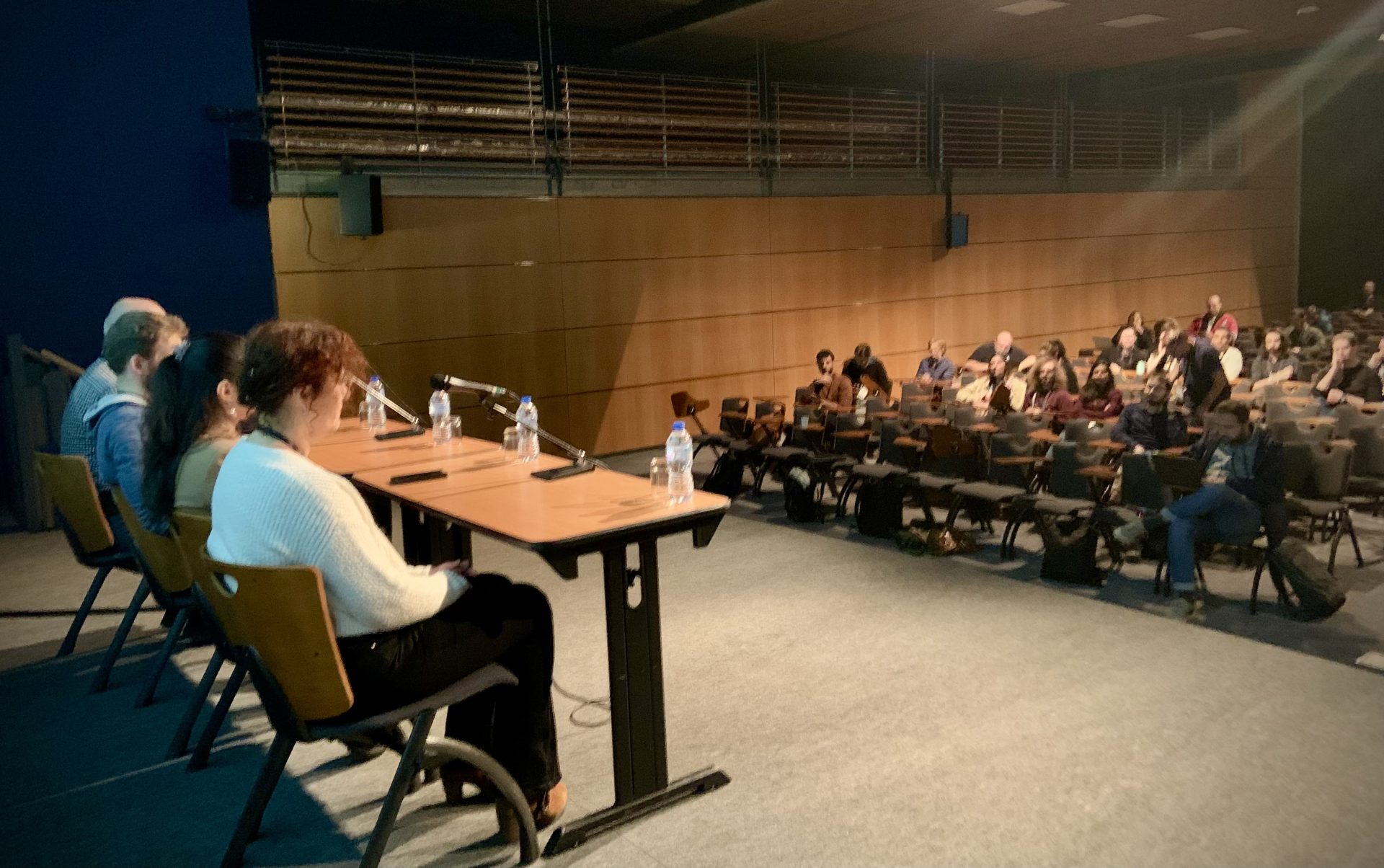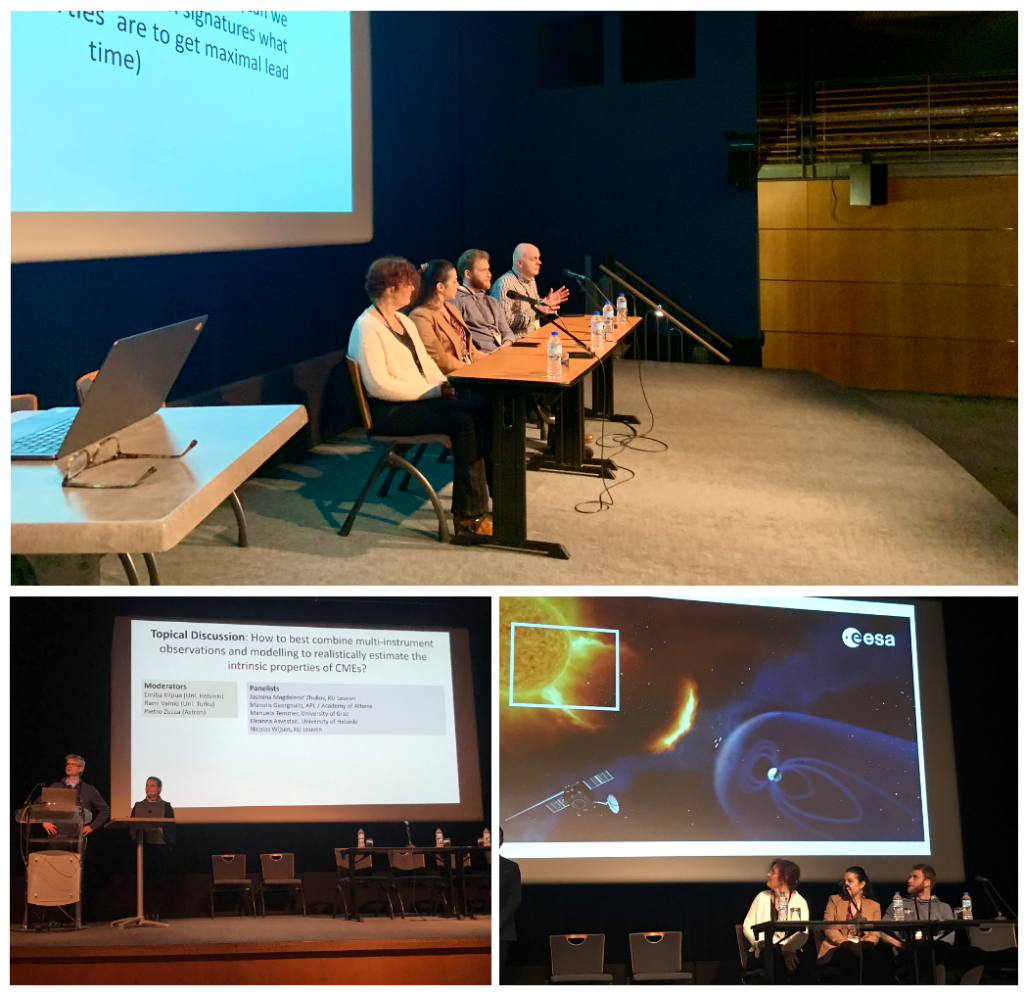
How to best combine multi-instrument observations and modeling to realistically estimate the intrinsic properties of CMEs? –
Solar eruptions hurl gigantic magnetized plasma clouds into interplanetary space and accelerate charged particles to relativistic energies. Their consequences at Earth are estimated using the modeling of the solar atmosphere and heliosphere. The first step in a successful space weather forecast is to estimate realistically intrinsic properties of solar eruptions.
Three on-going EU consortia (SWATNet, SERPENTINE and IDOLS) organized a topical discussion (TD) at the European Space Weather Week in Toulouse on 24 November 2023 focused on the status and challenges in deriving early eruption proxies and crucial parameters. The panel was co-chaired by Emilia Kilpua, Rami Vainio and Pietro Zucca.
We had three panelists, all experts of the discussed topics
- Eleanna Asvestari, an Academy Fellow at the University of Helsinki, Finland. She is an expert in heliospheric modeling and constraining coronal mass ejections (CMEs) in those models.
- Manolis Georgoulis, a Senior Professional Staff member at Johns Hopkins Applied Physics Laboratory (APL), USA, and a Research Director (on leave of absence) at the Academy of Athens, Greece. He is an expert in solar eruption proxies and magnetic field observations.
- Jasmina Magdalenic, a Professor at KU Leuven, Belgium. She is an expert in studying solar eruptions and dynamical processes in the solar atmosphere using radio observations.
- Manuela Temmer, an Associate Professor of astrophysics at the University of Graz, Austria. She studies solar eruptions from the Sun to their effects at Earth, in particular using Extreme Ultraviolet (EUV) observations.
- Nicolas Wijsen, a Postdoctoral Researcher at KU Leuven, Belgium. He is expert in modeling transport and acceleration of solar energetic particles (SEPs).
Our TD progressed as follows: We first gave an overview of the topic, and briefly presented the three primary projects organizing the event. Then, we asked a specific question prepared for each panelist followed by general discussion with the other panelists and audience. Key points are summarized below:
Manolis Georgoulis: “Do you think there is link between active region structure and intrinsic CME properties”
Manolis emphasized the importance of studying solar eruptions as a continuous chain from the pre-eruption phase to their effects in the heliosphere. He also reminded us of the importance of eruption proxies (e.g., for energy, helicity, peculiar flows and others ) derived from the solar photospheric surface using line-of-sight and vector magnetograms, but noted that statistical studies still give vague results. The discussion that followed brought up the limitations in magnetic field observations in the solar atmosphere. A major advancement would be having simultaneous and co-spatial observations from the chromosphere to derive magnetic field parameters and moments closer to the region where solar eruptions are born.
Jasmina Magdalenic: “What is the value of radio observations for early CME and SEP properties?”
Jasmina gave a comprehensive summary on how radio observations can help us predict space weather. For example, certain signatures in the radio continuum can be used as indicators for determining whether a fast and big CME is most certainly directed towards us. It was pointed out that this will be highly valuable when we will lose the SOHO spacecraft, which is soon approaching the final end of its mission. Radio observations can also give us additional evidence on whether there are more than one eruptions involved in cases where other observables indicate a single event, and reveal other complexities related to the eruption as well. In addition, type III radio bursts can help to indicate open field lines and the source at the Sun they most likely connect to. For space weather forecasts, automated approaches to extract key information from radio observations would be optimal. There are already methods developed for automated burst detection and for extracting features from dynamic spectra. These can provide estimates of the kinematic processes of the eruption and the density of the corona. Resolution of radio observations depend on the frequency. Higher frequencies can pinpoint very accurately the location of the radio source, while at lower frequencies there is a larger uncertainty.
Manuela Temmer: “What is the role of EUV observations in forecasting intrinsic properties of events?”
Manuela mentioned that EUV observations are essential, especially in combination with the white-light observations, for validating coronal models and for feeding information to empirical, analytical, and numerical models. Manuela reminded us that CME properties are set in the low corona that is currently captured best by EUV observations. These also provide crucial information e.g. on whether an event was front or back sided, whether a flare was confined or eruptive (coronal wave signatures), on CME propagation direction, as well as, how strongly it expands and accelerates. This early information on CME properties and evolution are vital for understanding SEPs. EUV dimmings and post-eruptive arcades pinpoint the region where an eruption took place and give estimates of the magnetic flux removed with the erupting CME flux rope. We should also not forget that EUV observations provide information on coronal holes that affect CME propagation and expansion. This question also sparked an interesting discussion about what instruments we should prioritize in future space weather monitoring satellite missions.
Eleanna Asvestari: “Can we currently (near) realistically constrain the current magnetized CME models in Heliospheric simulations?”
Eleanna discussed the importance of boundary conditions and input parameters necessary for constraining CME models, and emphasized how they can strongly affect the efficacy of the simulation output. She placed a lot of emphasis on the difficulties we are encountering on this subject. Despite the existence of methods to derive the intrinsic magnetic flux of CMEs, we are still far from determining near-real values with high confidence. The main reasons behind this are observational limitations, such as projection effects, lack of coronal magnetic field observations that are also essential for understanding the orientation of the flux ropes, and a lack of knowledge of the full Sun photospheric magnetic field in real time. These introduce uncertainties in the extracted values for the CME intrinsic flux that are then used as input to the models. Furthermore, the lack of full Sun observations impacts model ability to realistically constrain the ambient conditions through which we propagate the CME in the models. All the above have a significant effect on models that have the capability of launching magnetized CMEs, such as EUHFORIA, SUSANO, and EEGGL. Eleanna also highlighted that the complexity of solar eruptions can introduce uncertainties in extracting the magnetic field parameters. The knowledge collected thus far on the difficulties of this subject can be used as guides in designing future missions.
Nicolas Wijsen: “What are key observations needed to forecast SEP events? Are they more related to CMEs or pre-CME Heliospheric structures?”
Nicolas talked about the importance of taking into account the transport for SEPs in interplanetary space. He also pointed out that SEPs are particularly challenging to forecast as there is no time to wait for a CME. This is where the pre-eruption proxies and modeling the formation of the eruption become critical. Nicolas also reminded that it is not enough to model the eruption but modeling the background where SEPs propagate significantly affects the energetic particle characteristics that finally influence the Earth (or other location in the heliosphere). Making the magnetic connection between the source and the location of interest in the heliosphere is also paramount. In the discussion it was pointed out that the shock structure can have a huge importance on SEP acceleration. It is expected that CME-driven shocks in interplanetary space are not fully planar but can have rippled structure.
The one hour we had for the TD went by very quickly. The panelists raised several excellent points and the audience participated actively. What became clear from the discussion was that multiwavelength observations are critical for forecasting space weather events and their repercussions and they either give information on some unique aspects of the eruptions or complementary, but meaningful, estimates. The lack of reliable magnetic field information above the photosphere is one of the big current issues for forecasting space weather consequences of CMEs while for SEPs one needs to get estimates of the eruption characteristics low in the corona and pre-eruption proxies. For both, realistic modeling of the background corona and the solar wind is vital.
We thank all the panelists and the audience for participating in this Topical Discussion event! We greatly appreciated the fact that while the TD was essentially during the last working session of the conference, it was very well and lively attended.

